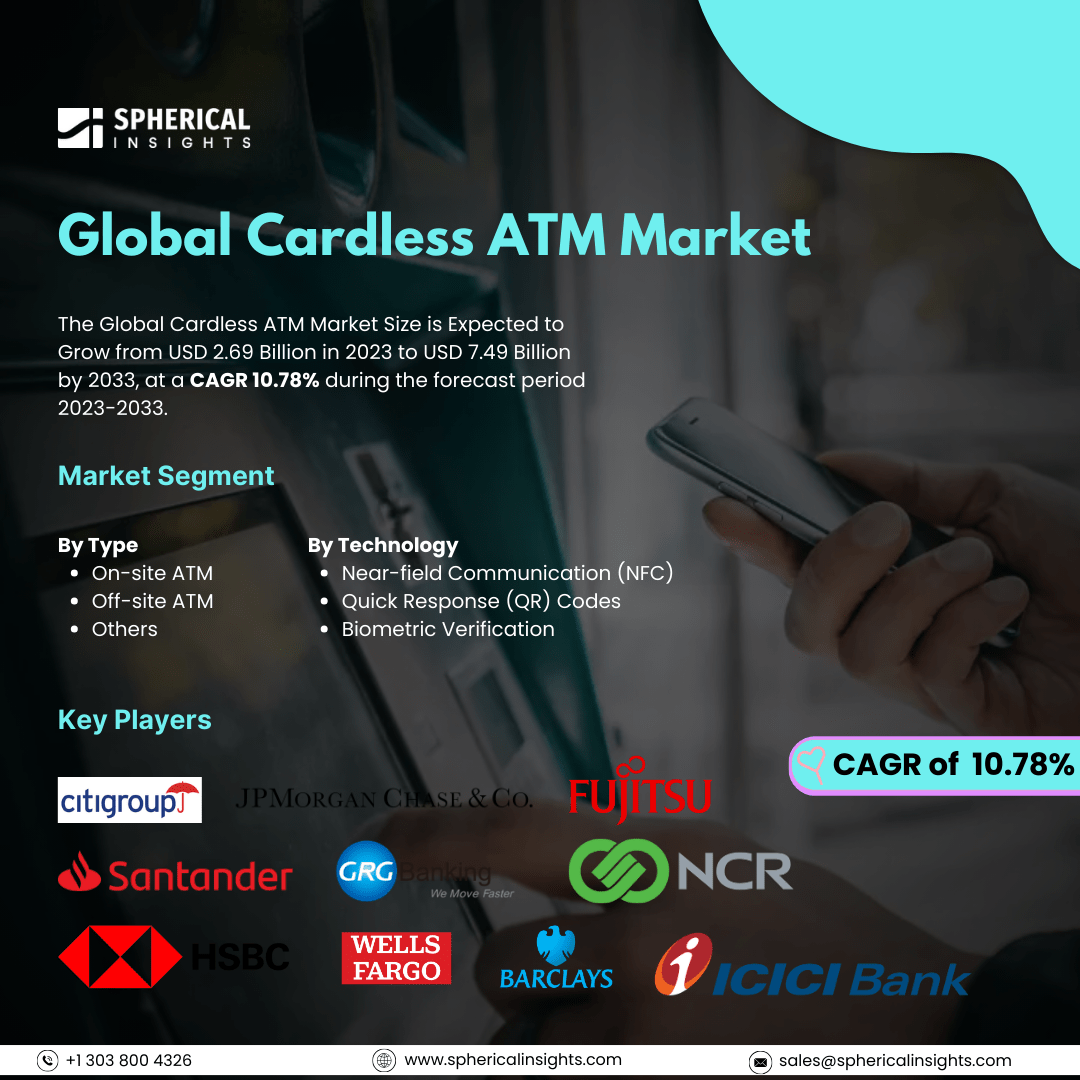Global Cardless ATM Market Size to worth USD 7.49 Billion by 2033
According to a research report published by Spherical Insights & Consulting, The Global Cardless ATM Market Size is Expected to Grow from USD 2.69 Billion in 2023 to USD 7.49 Billion by 2033, at a CAGR 10.78% during the forecast period 2023-2033.
Browse key industry insights spread across 210 pages with 110 Market data tables and figures & charts from the report on the Global Cardless ATM Market Size, Share, and COVID-19 Impact Analysis, By Type (On-site ATM, Off-site ATM, and Others), By Technology (Near-field Communication (NFC), Quick Response (QR) Codes, and Biometric Verification), and By Region (North America, Europe, Asia-Pacific, Latin America, Middle East, and Africa), Analysis and Forecast 2023 – 2033.
The cardless ATM market encompasses the development and use of ATMs that enable customers to conduct transactions without a debit card. This market is experiencing growth due to several factors, including the increasing number of smartphone users and the integration of banking applications with these devices. Near-field communication (NFC) technology facilitates contactless transactions by allowing users to tap their mobile devices on the ATM, often through mobile banking apps that simplify the generation and authentication of transactions. However, the cardless ATM market also faces challenges that may hinder its growth. A significant obstacle is the lack of widespread consumer awareness and understanding of cardless transactions, which can lead to a reluctance to adopt this technology. Additionally, security concerns related to mobile banking and the potential risk of fraud may deter some users from utilizing cardless options.
The on-site ATM segment is predicted to hold the largest market share through the forecast period.
Based on the type, the cardless ATM market is classified into on-site ATM, off-site ATM, and others. Among these, the on-site ATM segment is predicted to hold the largest market share through the forecast period. This is due to their accessibility and convenience for consumers, cardless ATMs are becoming increasingly popular. These ATMs, located within retail establishments and public spaces, provide immediate cash access without the need for card insertion, making them appealing to users seeking quick transactions. The integration of advanced technologies, such as mobile banking and biometric authentication, enhances both security and user experience, further driving their adoption.
The near-field communication (NFC) segment is anticipated to hold the highest market share during the projected timeframe.
Based on the technology, the cardless ATM market is divided into near-field communication (NFC), quick response (QR) codes, and biometric verification. Among these, the near-field communication (NFC) segment is anticipated to hold the highest market share during the projected timeframe. NFC (Near Field Communication) technology also facilitates seamless and secure transactions. It enables users to make payments simply by tapping their smartphones or NFC-enabled devices near compatible terminals, significantly enhancing convenience. This ease of use, combined with the increasing penetration of smartphones and a growing consumer preference for contactless payments, positions NFC as a preferred choice for both businesses and consumers in the evolving payment landscape.
North America is estimated to hold the largest share of the cardless ATM market over the forecast period.
North America is estimated to hold the largest share of the cardless ATM market over the forecast period. The demand for enhanced customer service and convenience drives the strong adoption of mobile banking solutions and innovative ATM technologies that support cardless transactions. Many financial institutions are investing in these advancements, creating a trend towards cardless ATM options. Additionally, heightened consumer preference for contactless payment methods has solidified North America’s leading position in this market.
Europe is expected to grow the fastest during the forecast period. The rapid adoption of digital payment solutions and the integration of advanced technologies in ATMs are key factors in market growth. The region's regulatory environment encourages innovation and competition among financial institutions, playing a crucial role in this development. Furthermore, a heightened focus on customer experience and the demand for secure, efficient transaction methods are prompting banks and ATM operators to invest in cardless technology, positioning Europe as a dynamic region for growth in the ATM market.
Company Profiling
Major key players in the cardless ATM market includes Citigroup Inc., JPMorgan Chase & Co., Fujitsu, Santander Group, GRG Banking, NCR Corporation, HSBC Bank A.S., Wells Fargo, Barclays Bank PLC, ICICI Bank Ltd., and Others.
Key Target Audience
- Market Players
- Investors
- End-users
- Government Authorities
- Consulting And Research Firm
- Venture capitalists
- Value-Added Resellers (VARs)
Recent Development
- In August 2024, The Reserve Bank of India has introduced a new feature that allows customers to deposit cash at ATMs using the Unified Payments Interface (UPI) instead of physical debit cards. This UPI Interoperable Cash Deposit service was launched at the Global Fintech Fest 2024, with the goal of streamlining cash deposits and improving banking convenience.
Market Segment
This study forecasts revenue at global, regional, and country levels from 2023 to 2033. Spherical Insights has segmented the cardless ATM market based on the below-mentioned segments:
Global Cardless ATM Market, By Type
- On-site ATM
- Off-site ATM
- Others
Global Cardless ATM Market, By Technology
- Near-field Communication (NFC)
- Quick Response (QR) Codes
- Biometric Verification
Global Cardless ATM Market, By Regional Analysis
- North America
- Europe
- Germany
- UK
- France
- Italy
- Spain
- Russia
- Rest of Europe
- Asia Pacific
- China
- Japan
- India
- South Korea
- Australia
- Rest of Asia Pacific
- South America
- Brazil
- Argentina
- Rest of South America
- Middle East & Africa
- UAE
- Saudi Arabia
- Qatar
- South Africa
- Rest of the Middle East & Africa



